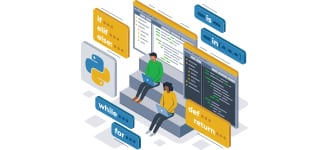Key takeaways:
- Python is a high-level, object-oriented programming language that has dynamic semantics.
- Python’s design emphasizes code readability through indentation properties.
- Python libraries are functioning sets that eliminate the need to write codes from scratch.
- The libraries help create models and applications in various fields with minimal coding, data analysis, and machine learning.
Python is a programming language used to build software and websites, conduct data analysis, and automate tasks. The general-purpose language helps to create multiple programs, and programmers prefer it because of its versatility. So, Python is the one-stop destination to develop websites and software, data analysis, task automation, and data visualization. Many non-programmers like scientists and accountants also adopt Python because it is relatively easy to learn.
The Python libraries of data science are collections of modules or codes that you can use in programs for specific operations. The libraries are function sets that eliminate the need to write codes from the beginning. You will find 137,000 python libraries now, and they play a vital role in developing data science, machine learning, data visualization, data manipulation, images, and applications.
The Python library includes around 200 modules that work together to make Python a high-level programming language. The library plays a significant role because programmers cannot access Python’s functionalities in its absence.
Python libraries are pre-written and help developers to program efficiently. The libraries provide application programming interfaces (APIs) that make it easy for developers to use them for software programs. So, the Python libraries offer flexibility and unique functionality for all tasks regardless of data type.
Why Python for data science?
Python is an open-source, interpreted language that provides a unique approach to object-oriented programming. Data scientists and programmers prefer Python for data science because of its simple syntax and ease of use flexibilities. The language is suited for quick prototyping, and any non-programmer can use it for different tasks and activities.
Data science projects in Python have become common in present times, and it is proving to be a language for the foreseeable future.
Here is a breakdown of why Python frameworks for data science have gained significance among programmers and non-programmers.
- Easy to learn
Python is an easy-to-learn language that enables you to start coding in no time. The language guarantees a quicker learning curve for data analysis and visualization not provided by other sources. Moreover, Python makes programs work with the fewest lines of code – it is an advantage for organizations that want to hire data scientists or analysts for domain expertise and programming tasks.
You can also access multiple online tutorials and resources when learning Python libraries for data analysis to increase your expertise in the niche.
- Scalability
Python is one of the most scalable languages used for data science. It has built-in flexibility to solve all kinds of problems. Moreover, you can use it for different purposes without worrying about its integration capabilities with websites, software, or applications. You can change the Python language in any shape or size per convenience without any hassle.
Python helps data analysis tasks to integrate with cloud computing platforms and web applications. The language helps in task integration when they are part of a larger project with multiple complexities. The scalable language runs on every operating system and platform and allows modules to get written in various languages and interfaces with API-powered services and libraries.
- Solid data science libraries
You can find Python data science libraries, such as Pandas, NumPy, SciPy, etc., that are powerful and broad and cover every math function in programming and data analysis. The data science libraries in Python specialize in multiple tasks – from high-level mathematical functions and linear algebra to handling data structures and operations.
That is why solid data science libraries are the best way to connect to databases, extract data, execute queries, and provide meaningful insights for business strategies and growth.
- Machine learning and algorithms
The Python-based learning experience has more demand in the market because hiring managers want data scientists with expertise in the programming language tools like Caffe, Torch, and TensorFlow. That is why Python is the best choice for language unity, machine learning work, and linked data structure that hold utmost significance for data scientists.
Machine learning and algorithms get supported in libraries for data science in Python. The programming language makes it easy to learn and do statistics, probabilities, and optimizations to implement algorithms in systems. So, the Python library offers algorithms for machine learning tasks and helps test and compare the modules under a centralized platform.
The combination of specialized machine learning activities makes Python uniquely suited to develop prediction engines and sophisticated models that can interface with a business system.
- Data visualization
The programmers working on Python have recently developed multiple solutions for data visualization. The language’s module system offers quality graphic and visualization options, such as power spectra, histograms, scatterplots, etc., with minimal coding.
New libraries built on Python modules provide opportunities to create and share unique charts and interactive visuals. So, the Python libraries for data science offer powerful advanced analytics combined with their machine learning capabilities for data visualization.
Python libraries for data science
| Scrapy |
| Beautiful Soup |
| SciPy |
| NumPy |
| Pandas |
| TensorFlow |
| Keras |
| PyTorch |
| Scikit-Learn |
| Matplotlib |
A Python library enables programmers to write code without the requirement to start from scratch. You can use Python to create applications and models in multiple fields, such as data science, machine learning, data manipulation, and visualization.
Here is a Python libraries list and their uses for data science to know if you want to excel in the field.
- Scrapy
Scrapy is an open-source, fast web crawling framework written in Python to extract data from web pages with XPath selectors. The Python framework is one of the best platforms for web scraping techniques or web data extraction. The process involves collecting data from websites by employing techniques like API.
- Beautiful Soup
Beautiful Soup is a Python library that helps pull data from XML and HTML files. It works with a parser to provide idiomatic methods related to search, navigation, and modification. The process helps save a programmer’s time and illustrates features for data documentation processes. The Python library is one of the easiest ways to scrape the required information from different web pages.
- SciPy
SciPy is a Python library that provides algorithms for integration, optimization, algebraic equations, interpolation, statistics, and other scientific computational processes. The library offers multiple data structures and algorithms applicable across domains. It also provides additional tools for array computing and specialized data structures like k-dimensional trees and sparse metrics.
- NumPy
NumPy offers multiple services like random number generators, mathematical functions, Fourier transform, linear algebra routines, etc. It is a fast and versatile Python library that provides indexing, vectorization, and broadcasting concepts for array computing. The library also offers multiple hardware and computing platforms for programming purposes.
- Pandas
Pandas is an easy-to-use, flexible, and powerful open-source data manipulation and analysis tool built on a programming language. It is one of the most used Python libraries for data analysis that offers data structures and operations to manipulate time series and numerical tables. The library aims to become a fundamental building block for real-world, practical data analysis in Python.
- TensorFlow
TensorFlow is one of the best Python frameworks for data science that helps create production-grade machine learning models. The Python library also allows you to use pre-trained models or create and train your own in its ecosystem. It also enables you to find ML solutions for skill levels and transform your research into production within a short period.
- Keras
Keras is an API that helps reduce cognitive loads by minimizing the number of user actions required for use cases. The Python library provides actionable error messages with extensive developer and documentation guides to run a system efficiently. It has the best learning framework among other data science libraries in Python.
- PyTorch
PyTorch is an open-source machine learning framework that creates a path between research prototyping and production deployment. The library enables scalable distributed training and performance optimization in production and research by the distributed backend. The best part about PyTorch gets well-supported among cloud platforms and provides frictionless development.
- Scikit-learn
Scikit-learn is a free machine learning library that offers efficient tools for predictive data analysis. It is a reusable library for Python programming language accessible to everybody in multiple contexts. The library features algorithms such as machine learning, gradient boosting, random forests, support vector machines, etc.
- Matplotlib
Matplotlib is a comprehensive plotting library under Python programming language and helps create animated, static, and interactive visualizations. The library helps create publication-quality plots, interactive figures, visual style and layouts, and file formats through third-party packages.
How can I become a Python pro?
Python is well designed and has multiple features making it one of the most used programming languages on the web. Its ease of readability and syntax makes learning easier for programmers and non-programmers.
However, you must have the experience to work on data science projects in Python. So, how do you become one?
You can enroll in relevant programs and courses to become a professional specializing in Python libraries for data science. The training programs will help you master the skills required to execute the programming languages on multiple platforms and run systems with minimal coding. You can also learn to collect structured and unstructured data and conduct manipulation and visualization via Python libraries.
The Manipal Academy of Higher Education with Online Manipal offers courses to help you ace your skills in data science and Python libraries. Here is a breakdown of the programs for students and professionals.
The Master of Science program in data science helps you learn technical skills and understand data analytics. You can learn multiple programming and skill sets related to Python, such as big data analytics, machine learning, statistics, etc.
The program also offers courses on predictive modeling and machine learning applications, real-world data development, and strategic and critical development recommendations to manage processes under Python’s programming languages.
You can choose the postgraduate program in business analytics, where you can select analytics and data science as an elective to enter the domain. The program will help you improve your skill sets as a professional Python developer and learn machine learning techniques, algorithms, math, statistics, etc.
You can choose the analytics and data science elective under your MBA program for better career opportunities in the domain of Python programming language.
In conclusion
Python libraries for data science are the best platforms to solve multiple tasks and challenges. Most data scientists leverage Python’s programming languages for data analysis, visualization, and manipulation. It is an easy-to-debug, easy-to-learn, open-source, object-oriented, high-performance language with multiple benefits. However, you must know Python basics and learn them to excel in data science.
You can choose the courses and programs from Online Manipal to master the concepts of data science libraries in Python. Join today.
Become future-ready with our online M.Sc. in Data Science program












